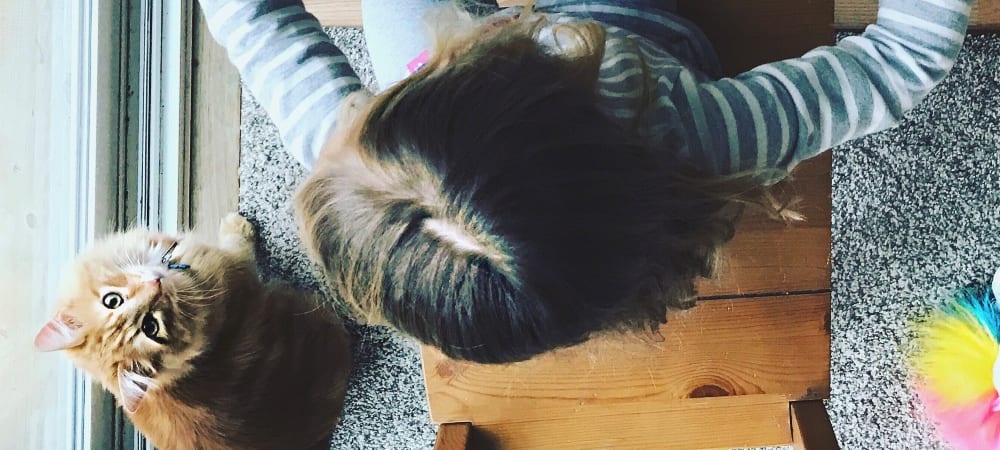How to Socialize a Cat

Cats have a particularly sketchy reputation in the personality department. They’re stereotyped as skittish, unfriendly, or in some cases, downright mean. So they don’t come running to the door when you come home and sometimes hide when company comes around – that’s okay! Cat lovers understand that this behavior comes with the territory of having a feline or multiple felines rule the roost.
The first step towards having a cat with a stellar personality is socialization. Socializing cats as kittens is extremely important, as they need the interaction with humans to become a pet. A cat raised in a colony of other cats will always be wild — feral — and once they reach a certain age they cannot ever be kept (in good conscious) as a pet.
When to Socialize a Kitten
The socialization process should begin as soon as the mama cat lets you near her young ones. Kittens as young as a few weeks old should be interacting with humans regularly. This means petting, playing and feeding, that is, if the kitten has been weaned.
Many shelters and rescues have kitten foster programs that help to save lives by opening up space for more animals, but these programs also help get kittens socialized. Kitten foster parents have a very important job in not only caring for their kittens but also paying attention to them, which makes them happy, healthy and ultimately, socialized and adoptable!
How to Socialize a Kitten
Very small kittens should have at least two hours of human interaction a day to ensure they trust people and become great pets. Socializing a kitten is very easy – all you have to do is be around them. Add to that playing, talking, touching, holding, petting and introducing them to a variety of human beings — kids especially! A kitten who is used to being around different people and can handle, well being handled, will likely grow up to be a well-adjusted cat.
Sometimes you’ll come across a kitten that doesn’t seem to warm up to you. This means you need to double down on the affection and attention. Make sure you’re around the kitten as much as possible, offering play, cuddles and even just kind words. It sounds crazy, but talking to your cat in a kind voice will make them soften towards you, even though they have no idea what you’re saying!
How to Socialize a Cat
Cats who have been rescued from very abusive or hoarding situations will need a specific kind of socialization process from a pet professional. The following advice is the steps you’d take if you’ve recently adopted a cat who appears to be shy, frightened of humans or hides constantly.
Okay, so you adopted an adorable new feline from your local rescue or shelter. Hooray! Naturally, you want to hug and kiss her and show her off to all of your friends and relatives, right? While this may work for a very outgoing cat, most cats need time to warm up.
Limit Their Space
For a newly-adopted cat, limit their space initially to a small room; even a bathroom will suffice. Let your cat get adjusted to his or her surroundings over a period of several hours up to a couple of days. Then, introduce new family members one by one by having them enter the bathroom and just hang with your new kitty. At first, your cat may ignore you, and that’s just fine. Just sharing the same space peacefully will signal to your cat that you don’t mean them any harm, which will start to build trust.
Once they’re comfortable with the space and its visitors, let him or her explore the home, but on their own. Give your cat space as he or she assesses their surroundings, allowing access back into the original small room. It may take a couple of rounds of your cat exploring and retreating until he or she is truly comfortable in your home and that’s perfectly fine. This process takes time and patience!
Engage in Play
Cats are hunters — nature’s best, in fact. Cats love a good round with a feather toy or a laser pointer. Make it a goal to play with your cat at least once a day for 10 – 30 minutes. Playing with your cat allows you to interact with them in a removed way. There’s you, them and the prey. This channels their energy towards the toy, makes it so they look forward to time with you and feeds their natural instincts. Follow playtime with mealtime — this way your cat associates hunting with eating, just like in the wild.
Reward Socialization
The ultimate goal of socialization is to have the cat come to you when he or she wants affection or attention, so reward him or her when it happens. When they come close and give you a rub, pet them back and then reward them with a treat.
Having trouble getting them to come close? Lure them to you with a toy or treat but don’t reach out to pet them as soon as they’re within arm’s length. Allow them to feel what it’s like to be next to you, or on your lap. When they go in for a rub, return it, on their cheeks or nose — cats love this — and keep the contact short. You want them to feel comfortable at all times, so don’t force anything. Let them take the lead and you follow. As a cat owner, you should be used to this anyway!
Some cats are always going to hide when people come to visit or greet your best friend with a hiss — it’s the feline way. However, you can encourage your cat to be more outgoing by showing them that their world — your home — is a safe place. It goes without saying, but never yell at or hit your cat in frustration or anger, this will just make them more frightened and timid. Provide them with a safe haven where they feel like they’re in control, give them plenty of play, attention and treats, and eventually you’ll be rewarded with rubs, chips and purrs.



